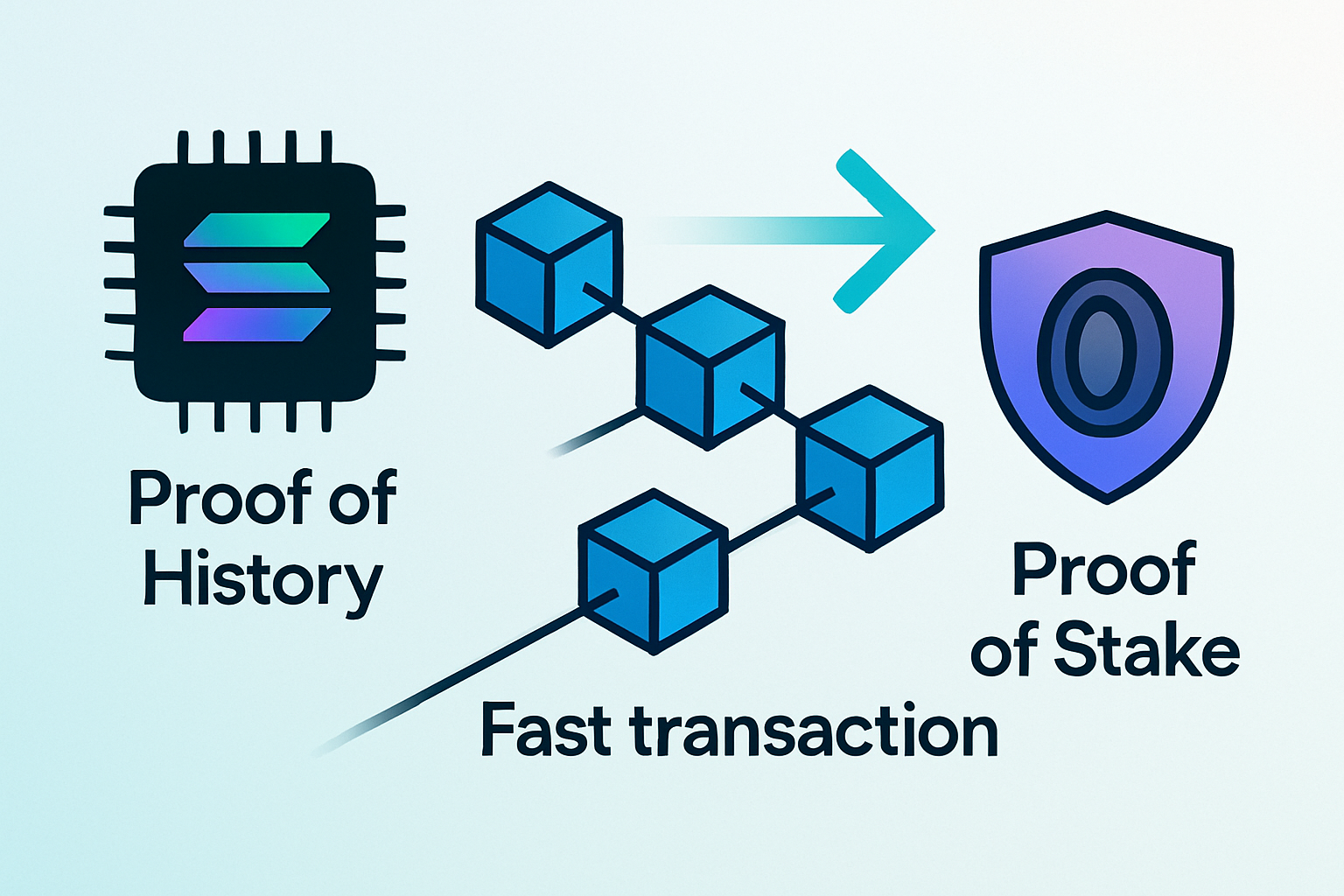What Makes Solana Different from Other Blockchains

Solana has rapidly carved out a name for itself in the blockchain world thanks to its eye-popping speed and knack for scaling with ease. Its unique design puts it in a league of its own and attracts developers, investors and everyday users who crave fast affordable transactions.
To really get a feel for what makes Solana tick it is best to start with the basics of blockchain technology. Think of blockchains as decentralized digital ledgers that keep track of transactions across many participants without putting all the eggs in one basket under a single authority. They nail down consensus on transaction history by using clever methods like Proof of Work (PoW) or Proof of Stake (PoS). Now most blockchains hit a wall when it comes to scalability—that is how many transactions they can juggle per second—and the speed at which those transactions clear.
What Solana Is, Broken Down Simply
Solana is a speedy high-performing blockchain designed to back decentralized apps and digital currencies while tackling the usual scalability headaches most blockchains struggle with. It offers lightning-fast transaction speeds and tiny fees, making real-time interactions feel almost effortless.
Distinctive Features That Truly Make Solana Stand Out
- Solana employs a unique Proof of History consensus mechanism that nails down transaction timestamps with impressive efficiency.
- It can handle a jaw-dropping throughput of up to 65,000 transactions per second without breaking a sweat.
- Transaction fees are tiny—usually less than a penny—which makes micro-payments not just possible but practical.
- Block times zip by quickly, averaging around 400 milliseconds so you’re not left waiting for confirmations.
- It pulls off scalability without leaning on sharding, a clever move that helps keep the network secure and decentralized.
- The developer ecosystem is friendly, supporting a variety of languages and frameworks that encourage innovation and adoption.
One of Solana's most impressive features is its Proof of History (PoH). This clever twist on consensus tackles the usual headaches and delays you see with classic Proof of Work or Proof of Stake systems by using a cryptographic clock to neatly line up events before locking in consensus. The result is a serious cutback on transaction processing times that feels like a breath of fresh air.
Proof of History The Secret Sauce Behind Solana's Lightning Speed
Proof of History acts like a cryptographic timestamp, neatly lining up transactions in order before the network gives them its stamp of approval.
Proof of History works with Solana's Proof of Stake system to keep the network running smoothly and securely. PoH provides a verifiable way to track the passage of time between events. PoS helps validators quickly agree on the ledger's state without missing a beat. Together, they blend efficient timing with decentralized consensus allowing Solana to lock in blocks quickly. You can learn more about Proof-of-History on AO Kings.

Illustration showing how Proof of History orders transactions and integrates with Proof of Stake to secure Solana's network.
High Throughput and Scalability That Don’t Even Need Sharding
Solana can process up to 65,000 transactions every second which is impressive especially in decentralized networks where that speed is rare. Remarkably it achieves this without using sharding, the usual method of slicing a blockchain into smaller chunks.
Low Fees with Quick Confirmation
One of the big draws with Solana is how blazing fast and dirt cheap the transactions are. On average, you are looking at a fee of around $0.00025 which keeps things affordable for anyone wanting to hop on board. Transactions usually settle in about 400 milliseconds—blink and you’ll miss it. This is quite a leap compared to Ethereum where things can drag on for minutes when the network gets crowded or Bitcoin where blocks take a leisurely 10 minutes to confirm.
| Blockchain | Transaction Speed | Average Fee | Consensus Mechanism | Throughput Capacity |
|---|---|---|---|---|
| Solana | Around 400 milliseconds, lightning fast really | A tiny $0.00025, almost pocket change | Proof of History teamed up with Proof of Stake, a clever duo | Nearly 65,000 transactions per second, no kidding |
| Ethereum | Usually between 10 and 20 seconds, give or take a bit | From $1 up to $20, depending on the traffic jam | Proof of Stake, doing its best to keep things green | About 30 transactions per second, steady and reliable |
| Bitcoin | Roughly 10 minutes, patience is a virtue here | Between $1 and $5, can add up if you’re not careful | Good old Proof of Work, the original heavy lifter | Around 7 transactions per second, slow but sure |
Developer Ecosystem and Expanding Applications A Growing Playground
Solana’s growing influence isn’t just talk—it’s powered by a vibrant and rapidly expanding ecosystem catching a lot of attention. Developers often lean towards it because it scales well, stays flexible and works with popular programming languages. Within this ecosystem, you’ll find decentralized finance (DeFi) protocols and a colorful array of non-fungible tokens (NFTs). Plus, it’s paving the way for fresh innovations like blockchain gaming thanks to its low latency and cost efficiency.
- Solana is home to many popular dApps from decentralized exchanges to NFT marketplaces that pull in millions of users.
- Developers appreciate the rock-solid SDKs and libraries that make building and integrating apps much easier.
- The network supports languages like Rust and C, welcoming a diverse crew of developers.
- Its lightning-fast transaction speeds enable creative adventures like gaming, microtransactions, and real-time data apps that cannot wait.
- A buzzing community and regular hackathons keep the vibe upbeat and foster collaboration, helping fresh projects take off quickly.
Common Misunderstandings and Challenges Around Solana What You Might Not Have Realized
Although Solana has its strengths, there’s a bit of confusion floating around about just how decentralized and reliable it truly is. Many people seem to assume it’s immune to outages or that it operates just like time-tested giants such as Bitcoin. Solana has experienced network outages and faces its fair share of challenges, especially because running validator nodes demands some pretty beefy hardware.
- Solana has stumbled through a few network outages caused by heavy traffic spikes and annoying software bugs. This shows that even the newest technology has quirks.
- Running validator nodes is challenging because it requires powerful and costly hardware. This setup might discourage casual participants and raise concerns about centralization.
- Critics openly highlight the risks involved. Control of the network could become concentrated among a smaller group of validators compared to more established blockchains.
- Compared to Ethereum and Bitcoin, Solana is still the newcomer. Its ecosystem is expanding but many features and decentralized applications are still works in progress, making the space more exciting.
The Solana Foundation and its community are rolling up their sleeves and actively diving into performance improvements while steadily paving the way for greater decentralization. It involves software updates to boost the network's resilience, careful tinkering to fine-tune validator hardware requirements, and initiatives to bring more validators on board from various parts of the globe.
A Closer Look at Comparing Solana with Other Leading Blockchains
When sizing up Solana alongside heavyweights like Ethereum and Bitcoin it leans into lightning-fast transaction speeds and wallet-friendly fees while keeping security reasonably tight. This may mean giving a little ground on decentralization. Newer blockchains often juggle a mix of priorities. Solana feels tailor-made for apps that crave speedy processing and budget-conscious operation.
| Feature | Solana | Ethereum | Bitcoin | Newer Competitors (e.g., Avalanche) |
|---|---|---|---|---|
| Consensus | Proof of History mixed with Proof of Stake, a combo that’s pretty unique in the blockchain world | Proof of Stake, which has become the go-to for many these days | Proof of Work, the classic heavyweight champ | Proof of Stake or similar flavors, each trying to carve out their niche |
| Transaction Speed | Lightning-fast at around 400 milliseconds, almost like blink-and-you-miss-it | Typically takes about 10 to 20 seconds, which in blockchain time feels like ages | Roughly 10 minutes, so you might grab a coffee while waiting | Usually zips through in 1 to 2 seconds, quite the speedsters |
| Transaction Fee | Dirt cheap at roughly $0.00025, hard to beat | Can swing anywhere between $1 and $20, depending on network traffic and luck | Around $1 to $5, not too shabby but not wallet-friendly either | Varies but generally keeps fees on the lower side, a nice little bonus |
| Throughput TPS | Can rocket up to 65,000 transactions per second — talk about handling a crowd | About 30 transactions per second, solid but could feel like a slow dance sometimes | Roughly 7 transactions per second, definitely not winning any speed contests | Often handles thousands, striking a balance between fast and functional |
| Ecosystem Size | Growing at breakneck speed with a smorgasbord of dApps popping up | Largest and most established ecosystem out there, like the granddaddy of them all | Large but moving at a more measured pace | Expanding too, often zeroing in on scaling to keep up with demand |
| Scalability Approach | Runs a single chain without sharding, leaning heavily on Proof of History’s clever time-stamping | Slowly inching towards sharding and Proof of Stake, a smart move for the future | Relies heavily on layer 2 solutions to ease the pressure | Dabbling in sharding and DAG-like structures, mixing it up to find the sweet spot |
| Network Maturity | Still ironing out the wrinkles with ongoing improvements, kind of like a startup vibe | Well-established and widely used, feels like a trusty old friend | The most mature and trusted network, the gold standard really | Newer on the scene but packing some innovative punches |
While no blockchain is completely flawless, Solana really manages to strike a rare balance with its impressive combo of high speed and scalability. From what I’ve seen, it tends to shine brightest in applications that crave fast, low-cost transactions without breaking a sweat.
Final Thoughts on Whether Solana Might Just Be the Right Fit for You
Choosing Solana really comes down to what floats your boat—whether you are a developer chasing a fast scalable platform or a user who wants speedy low-cost transactions without the fuss. Getting acquainted with Solana's unique features can make all the difference when you are diving into the blockchain world. Squeeze every bit of potential out of Solana by learning more and see what it is all about.




